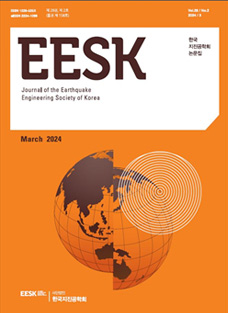1. 서 론
지금까지의 설계용 지진동 평가는 크게 나누어 두 가지 방법을 통해 이루어졌다. 한 가지는 엄격한 의미의 정상성(ergodicity)을 가정한 통계 기반 모델(statistics-based model)이고, 다른 한 가지는 지진동에 관한 물리 이론을 토대로 한 이론 기반 모델(physics-based model, 이하 PBM)이다. PBM의 경우 지진동의 스펙트럼 특성에 관한 표현 정리(representation theorem)를 바탕으로 이론적인 설명이 가능하므로[1] 설계용 지진동의 이론적 합리성을 논의하기 위한 토대로 활용할 수 있고, 이론의 발전과 더불어 모델을 구조적으로 고도화시킬 수 있다는 장점이 있다.
PBM은 크게 3가지 부분으로 나눌 수 있는데, 첫 번째는 단층의 파열에 관한 진원 모델이고, 두 번째는 진원에서 발생한 파동이 관측점 주변의(지진 또는 공학적) 기반암까지 도달하는 과정을 나타내는 전파경로 모델, 그리고 마지막으로 상대적으로 연약한 표층 지반의 복잡한 증/감폭 과정을 나타내는 표층 지반 모델로 나눌 수 있다. 본 논문의 대상인 진원 모델은 단층 파열의 시작에서부터 끝나기까지의 전 과정을 나타내는 모델이라고 할 수 있다. 단층 파열의 시작은 pre-slip 모델과 cascade 모델이 주로 인용되는데, 최근의 실험 연구에서는 이들 두 가지가 복합적으로 작용하여 단층 파열 핵(rupture nucleos)이 형성된다고 본다[1]. 즉, 모델의 특정 영역의 전단강도가 주변의 응력보다 낮아서 전단파괴가 시작되고 파괴된 부분의 응력이 다른 부분에 재배분되는 과정에서 부분적인 파괴가 순차적으로 발생하게 되며, 이 과정에서 전단강도가 가장 강한 부분인 asperity에 응력 집중이 발생 하고 전단응력이 최댓값에 도달하면서 단층의 파열과 함께 고속의 불안정한 동적 미끄럼이 발생한다. 이 과정에서 단층 파열의 역학적 에너지는 지진파 방출에너지와 단층면의 파쇄 및 마모 등에 의한 마찰에너지, 그리고 마찰에너지의 열 변환에 의한 열에너지로 평형을 이루게 되고, 최종적으로는 barrier 효과를 포함한 마찰 저항의 우세로 미끄럼이 멈추게 되면서 일련의 단층 파열 과정이 끝나게 된다. 이들 과정에서 asperity의 전단파괴를 중심으로 이전 과정을 준 정적 거동(quasi-static behavior)에 의한 pre-stage, 이후 과정을 준 정적 거동에서 단층 파열 속도에 도달하기까지의 가속화 단계(accelerating stage)와 단층 파열 속도에 도달하여 자기 유사성 균열 확장(self-similar crack propagation)이 일어나는 불안정한 파열 전파 단계(unstable rupture propagation stage)로 나눌 수 있다[2]. 이들 과정 중 가속화 단계를 breakdown process(이하 BDP)라고 부른다. 지금까지 BDP의 특성은 주로 화강암이나 엔지니어링 플라스틱(PMMA), 폴리카보네이트(PC) 등을 이용한 실내 실험을 통해 규명되었지만[3], 이들 실험 결과와 실제 단층 파열 과정과의 관계는 BDP를 지배하는 변수의 scaling 특성이 불분명하여 실험에서 밝혀진 현상이 단층의 파열을 정량적으로 설명하는데 충분하다는 보장이 없고, 실험체의 크기에 따라 결과가 다르게 나타나는 규모 효과(size effect) 문제도 미해결 상태이다[4]. 이런 문제점을 해결하기 위해서는 유체의 경우와 같이 BDP를 지배하는 변수의 규모 의존성(scale dependence)을 무차원수로 나타낸 동적 유사성 모델로 정립하고, 실내 실험과 실제 지진에서 동적 유사성 모델을 이용한 기하학적 상사 법칙(geometrical similarity law)이 규모 의존성을 설명할 수 있음을 보여야 할 것이다.
이에 본 논문에서는 BDP의 지배방정식에 주목하여 단층 파열 과정의 에너지 수지를 지배하는 무차원수를 도출하고, 이무차원수를 통해 BDP와 그 이후의 균열 확장과정의 동적 유사성을 규명하고자 하였다. 그리고 규명한 동적 유사성이 저속 유체의 동적 유사성과 본질적으로 다르지 않음을 보였고, 나아가 단층 파열 면들 사이의 gouge와 같은 입상체(granular media)의 거동을 지배하는 무차원수와의 관계를 고찰하여, 본 논문에서 제시한 무차원수가 단층 내외부 거동의 연속성과 밀접한 연관성을 갖고 있음을 보였다. 본 논문에서의 자기 유사성은 Broberg[5]의 정의에 따라 단층 파열 속도가 규모 의존성 없이 일정함을 의미한다.
2. 단층 파열 과정의 특성 관계식
2.1 지배방정식과 특성 관계식
단층 파열 과정을 간단히 표현하기 위해 단층 파열 면은 균일한 응력이 작용하는 균질한 등방성 2차원 동탄성체(elastodynamic bulk) 중 y=±0에 서 x축 방향의 유한 길이 직선으로 나타내기로 하고, 이 직선의 길이를 단층 파열 면의 길이로 한다. 그리고 상대 미끄럼 변위(이하 변위)는 y=±0에서 x 방향으로 각각 ±Δu가 발생한다. 이때 y=±0에서의 응력이 같다는 것을 경계조건으로 다음과 같은 2차원 파동방정식을 고려한다.
식 (1)에서 ρ, μ는 각각 탄성체의 밀도와 전단탄성계수를 나타내고 U는 변위 장(displacement field)을 나타낸다. 단층 파열 속도 Vr이 일정하다고 가정할 때 x′ =x-Vrt, y′ =y, t =t′의 Galilean 변환을 하면 균열의 선단 이 항상 x′ =0에 고정된 좌표시스템으로 바뀌게 되고, 식 (1)은 의 관계식을 이용하여 다음과 같이 쓸 수 있다[6].
경계조건을 만족하는 식 (2)의 전단파괴 모드(Ⅱ, Ⅲ형) 별 해는 단층 파열 면의 입자 변위 또는 운동 속도와 응력과의 관계를 나타낸다. 즉,
여기서, σm은 (x,y)에서 파괴 모드 m에 관한 전단응력, Cm(Vr)은 속도계수를 나타내고, υ는 미끄럼 속도를, 그리고 ξ는 단층 파열 면내의 좌표를 나타낸다. 이하에서는 식의 표현을 간단히 하기 위해 방향과 관계없이 U,u는 변위를 나타내고, V,υ는 속도를 나타내는 것으로 한다.
식 (3)은 파열 면에서의 전단응력과 미끄럼 속도가 Hilbert 변환과 역변환의 관계임을 나타내는데, 이러한 조건을 만족하는 전단응력과 미끄럼 속도 또는 변위를 이용해 단층 파열 면에서의 응력과 변위와의 관계 또는 응력과 미끄럼 속도와의 관계를 나타낸 것이 마찰 법칙(friction law) 모델이다. 마찰 법칙에 관한 모델은 다양한데, 이를 크게 분류하면 1) rate- and state-dependent weakening 모델(RSWM)과 2) slip-dependent weakening 모델(SWM)로 나눌 수 있고, 동역학적 단층 파열 모델의 수치해석을 통한 검토에서 이들 두 가지 모델이 서로 유사한 결과를 보여[7], 형식이 간단한 다음의 선형 SWM을 많이 사용한다. Fig. 1에 선형 SWM을 나타낸다.
위 식은 단층면 (y=±0)에서의 상대 변위 Δu에 따른 응력의 변화 τ를 나타내는데, σp는 전단 항복 이후의 최대 전단응력을 나타낸다. 한편, 전단 항복 이후엔 소성변형이 발생하므로 응력이 σp에 도달하기 이전에 Δu는 0 보다 크지만, 그 크기가 응력이 σp에 도달한 이후에 발생하는 Δu와 비교해 작다고 보고 모델의 간략화를 위해 Δu =0일 때의 응력으로 가정한다. 그리고 Δu가 임계 미끄럼 거리(critical slip distance)Dc를 초과하면 응력은 일정한 잔류응력 σf와 같다고 가정한다. 여기서 0≤Δu≤Dc의 구간을 breakdown zone(이하 BDZ) 이라고 하고, Δσb =σp -σf를 BDZ에서의 응력 강하량이라고 한다. 응력 강하량은 응력 강하율(breakdown rate) W=Δσb/Dc에 비례하여 Δu의 변화에 따라 선형적으로 변화하는 것으로 가정하는데, 이것은 응력 강하량을 τ=σp -AΔun처럼 Δu에 대한 멱함수로 나타낼 때 멱함수의 승수 n이 2/3를 초과하면 n=1의 경우와 특성이 유사하다는 이론 연구 결과[8-10]를 반영한 것이다. 식에서 A와 n은 모두 양의 상수이다. 한편, Abercrombie and Rice[11]는 적용 모델에 따라 다르지만, Brune의 유효 응력에 관한 식을 적용 했을 때 n≃0.59의 결과를 얻었고, Choi and Yoon[12]은 선형 SWM을 수정한 확장 SWM(ESWM)을 이용해 일본에서 발생한 지진동 기록의 스펙트럼 역 해석 결과를 재해석하고, 그 결과를 Ohnaka의 실내 실험 결과 등과 함께 검토해 Abercrombie and Rice의 결과와 거의 같은 결과를 얻었다. 이들 연구에서 얻은 n값은 이론 연구에서 얻은 임곗값 2/3와 매우 비슷하므로 n=1을 가정한 식 (4)는 충분히 타당한 설정이라 할 수 있다.
식 (4)를 적용한 식 (3)의 결과는 다음과 같이 나타낼 수 있는데, 이를 BDZ의 구성 법칙(constitutive law) 또는 scaling 관계라고 한다[2].
여기서 μ*는 전단파괴 형식에 따라 μ(anti-plane (Ⅲ형) 모드) 또는 μ/(1-ν)(in-plane (Ⅱ형) 모드)로 정의된다. ν는 재료의 푸아송비를 나타 내는데, 이하에서는 모드의 구분 없이 μ를 사용하기로 한다. β는 식 (3)의 Cm(Vr)을 포함한 단층 파열 속도 Vr의 영향을 나타내는 계수로, Uenishi와 Rice[8-10], Campillo and Ionescu[13], Prefettini et al.[14], Favreau et al.[15]은 2차원 및 3차원 문제에서 파동방정식의 고유치 해석을 통해 β =1.158∼2.596의 식 (5)가 universal function임을 증명하였다. Lc는 BDZ의 크기를 나타내는데, 등방성 재료의 경우 BDZ의 형상이 축 대칭이므로 full length(2Lc) 또는 half length(Lc)를 나타낸다. 위의 β는 full length에 대한 것으로, Fig. 1에 보인 half length에 대해서는 1/2값을 사용하여 β≃1이 된다. 이때 Lc는 Δu =Dc 일 때 균열의 길이를 나타낸다.
한편, Campillo and Ionescu[14]는 BDZ의 임계 미끄럼 변위 Dc를 다음과 같이 정의하였다.
여기서 두 번째 등식은 변수변환 x′ =x-Vrt을 고려한 것으로 Lc =Vrtb임을 알 수 있다. 시간 tb는 Δu가 Dc에 도달하는 시간으로 정의하는데, 파열 핵 형성 과정의 시간 기점을 정의하는 것이 현실적으로는 불가능하므로, 식 (4)처럼 σp에서 응력강하가 시작되는 시점부터 처음 σf에 도달할 때까지의 시간으로 정의하기로 한다. Tinti et al.[16]은 이 시간을 동적 응력강하 시간(dynamic breakdown time)이라 하였고, Mikumo et al.[17]은 동적 응력 강하 시간이 입자의 운동 속도가 준 정적인 상태에서 최대속도에 도달하기까지의 시간과 거의 같음을 이론 모델의 수치해석을 통해 보였다. 그리고 Ohnaka and Yamashita[18]는 진원 가속도 스펙트럼의 고진동수 영역 차단진동수 fmax (source-controlled fmax )를 다음과 같이 정의하였다.
식 (5)~식 (7)을 이용하면 다음의 BDZ에 관한 무차원수와 특성 관계식 을 얻을 수 있다.
여기서 υp는 BDZ 입자의 최대 운동 속도를 나타낸다. 한편 Ida[19]는 다양한 형태의 응력강하 모델을 검토해, 식 (9)와 함께 다음의 최대 운동가속도 ap에 관한 식을 제시하였는데, Ohnaka and Yamashita[18]는 화강암을 이용한 stick-slip 실내 실험에서 식 (8)~식 (10)이 성립함을 보였다.
식 (11)의 왼쪽 첫 번째 등식에서 알 수 있듯이 입자의 최대 운동가속도는 ϑt′v=(∇∙υ)υ로 정의되는 대류 가속도(convective acceleration)와 같은 차원으로 정의되었는데, 이는(t′,x′,y′)과 같은 등속 이동 좌표계에서 이동속도에 대한 시간 미분은 0이기 때문이다[6]. 그리고, 여기서 한 가지 주의할 점은 식 (9)~식 (11)의 왼쪽 첫 등호는 엄밀한 의미의 등호가 아니라 β≃1의 의미에서 등호 관계를 나타낸다. 한편 Ohnaka and Yamashita[18] 는 stick-slip 실내 실험 결과와 식 (11)을 비교하여 식 (11)에 3.6~4.4의 계수(virtual coefficient h)를 곱한 모델을 제시하였다.
2.2 단층 파열 과정의 에너지 수지 관계
BDZ의 응력강하와 이에 따른 변위로 소비되는 에너지를 단층 파괴 에너지(fracture energy EG)라 하고, 다음과 같이 정의한다(Fig. 1 참조).
여기서 A는 단층 파열 면의 면적을 나타낸다. 과거에는 식 (12)의 단위 면적 당 파괴 에너지를 파괴 에너지 방출률(fracture energy release rate Gc)로 정의하였는데, 최근 전문가 집단[20]의 검토에서 단층 파괴 에너지는 새로운 균열 면의 생성에 소비되는 파괴 에너지와 미끄럼마찰로 발생하는 열에너지가 혼합되어 있고, 이들 에너지를 명확히 구분하는 것이 현실적으로 어려우므로 파괴 에너지의 방출률은 용어로써 부적합하다는 의견과 함께, 이를 보완하기 위해 breakdown work를 사용하자는 권고가 있었다. 이하에서는 이 권고에 따라 식 (12)를 파괴 에너지 방출률 Gc 대신 breakdown work Wb라 부르기로 한다.
한편, 지진파 방사 에너지(wave radiated energy ER)는 그림에서 알 수 있듯이 다음식으로 정의한다.
여기서 Δu는 미끄럼 변위의 단층 파열 면적 A에 대한 평균을 나타낸다. 그 외에 마찰에너지(friction energy EF)를 다음과 같이 정의한다.
위의 3가지 에너지를 전부 합한 것이 단위 면적당 전체 방출 변형에너지(total strain energy release ΔW/A)인데, 이들 중 마찰에너지는 잔류응력 σf를 알 수 없어 불명확하므로 이를 제외한 나머지의 합, 즉 ΔW0를 유효에너지라 부른다[21]. 그리고, 지진파의 방사 효율(seismic wave radiation efficiency) ηR은 다음과 같이 정의한다.
여기서 한 가지 주의할 것은 ER 의 정의가 서로 다른 방사 효율과 방사율(radiation rate)의 구분이다. 방사율의 경우 Kostrov and Das[22]의 정의에 따라 파열 면 내부 응력의 평균과 시간에 따른 변화를 고려한 ER의 정의를 사용하는데 이 경우에는 응력의 시간 변화분에 의해 ηR >1도 이론적으로 가능하다[23]. 그러나 이 경우 수치해석처럼 단층 파열 면의 응력의 시간 변화를 정확히 파악하기는 현실적으로 어려우므로, 여기에서는 기존 연구 [1]와 마찬가지로 진원 시간 함수를 omega-square 모델로 가정했을 때 점 진원으로부터 구면 방사를 통해 방사되는 전체 방사 에너지를 ER로 정의하기로 한다. 즉, P파와 S파에 의한 에너지 방사 비율은 S파에 의한 방사량이 훨씬 크다는 연구 결과를 고려하여 다음과 같이 쓸 수 있다[24].
여기서 〈 〉는 S파 방사 패턴의 2승 평균을, fc는 진원 스펙트럼의 코너 진동수를 나타내는데, tc ≃1/fc의 관계가 성립하고, 단층 파열 속도 Vr과 단층 반경 R을 이용해 다음과 같이 정의한다.
식 (16)을 사용하여 방사 효율을 평가하면 모멘트 방출률의 2승 적분을 사용하기 때문에 항상 ηR <1이 되는데, 이때 한 가지 점 진원의 모멘트 방출 률에 대해 가정한 omega-square 모델의 타당성은 확인할 필요가 있고, 이에 관해서는 4장에서 다루기로 한다.
3. 무차원수를 이용한 에너지 수지 관계 표현
3.1 BDZ에서의 Reynolds number Reb
단층 파열 과정의 전체 변형에너지 ΔW 는 단층 주변의 탄성체에 축적되었던 변형에너지가 단층 파열 과정에서 에너지 공급원의 역할을 한 것으로 볼 수 있는데, 현실적으로 열에너지는 구분해서 평가할 수 없으므로 일부분인 유효에너지ΔW0 의 에너지 수지 관계만을 평가하게 된다. 유효에너지를 구성하는 breakdown work와 방사 에너지의 비율은 식 (1)의 운동량 보존(momentum conservation) 관계식을 이용하여 정의할 수 있다. 즉, 식 (1) 의 좌변을 comma convention을 이용하여 응력과 속도에 관한 표현으로 바꾸면 다음과 같다.
이때 우변의 응력 항에서 전단 저항에 관한 것만을 이용하여 대류 가속도에 의한 관성력과의 비율을 정의한 것이 유체역학에서 사용하는 Reynolds number Re이다[25]. 즉,
식에서 μF와 νF =μF /ρ는 각각 유체의 점성계수와 동점성계수를 나타내고, “~”는 차원해석의 등가성을 나타낸다. 그리고 L,V는 각각 거리와 속도 차원의 변수를 나타낸다. Re는 관성력과 이에 대응하는 점성에 의한 전단 저항력과의 비를 나타낸다고 할 수 있다. 관성력에 비해 전단 저항이 커지면 점성에 의한 에너지 소비로 입자 운동이 활발하지 못하고, 반대로 관성력이 크면 난류처럼 입자 운동이 활발하게 일어나게 된다.
한편, 차원해석의 등가성을 이용하면 탄성체에서도 같은 의미의 무차원 수 Re′을 정의할 수 있다. 즉, μF ∼μt이므로 시간에 대한 차원 표현으로 L/V을 사용하면 식 (19)를 탄성체에 대한 식으로 정의할 수 있다.
여기서 L,V는 거리와 속도 차원의 대푯값을 설정하면 되므로, Lc 와 Vr을 각각 선택하면 Re′은 다음과 같이 정의된다.
그리고 식 (19)는 BDZ의 응력 gradient와 Ida의 BDZ에 관한 특성 관계 식인 식 (9)와 식 (11)을 이용하여 다음과 같이 쓸 수 있다. 이것을 BDZ의 Reynolds number Reb로 정의한다.
여기서 이고 BDZ 입자의 최대 운동 에너지를, 분모의 Wb/Lc 는 breakdown work gradient라 한다. 위 식에 식 (9)의 υp와 Vr의 관계를 대입하면 BDZ의 Reynolds number는 차원해석을 통해 정의한 탄성체의 Reynolds number와 같게 된다. 즉
식 (22)와 식 (23)에서 알 수 있듯이 breakdown work gradient와 입자의 최대 운동 에너지의 비는 단층 파열 속도의 제곱에 비례한다. 만약 Δσb가 지진의 규모에 의존하지 않고 일정하다면 식 (5)의 Dc/Lc가 일정하고, Wb/Lc도 지진의 규모에 의존하지 않고 일정하여야 한다. 이는 Wb∝Lc 임을 의미하지만, 선형탄성 파괴역학(Linear Elastic Fracture Mechanics, 이하 LEFM)의 이론만으로 설명하기에는 한계가 있다. 한편, 식 (8)의 특성을 갖는 Lc의 규모 의존성은 Cocco et al.[26]이 제기한 Wb, Dc가 규모 의존성을 갖는데, Δσb는 왜 일정한가라는 의문에 대한 하나의 답이 된다.
또 다른 가정으로 최근 암석을 이용한 실내 실험의 결과[27,28]처럼 Δσb∝υp라면 BDZ의 구성 법칙인 식 (5)가 성립하기 위해서는 식 (9)의 단층 파열 속도 Vr이 일정해야 한다. 이와 같은 관계는 단층의 동역학적 파열에 관한 수치해석에서도 확인된다[16]. 그러나 기존 연구[24]에서 이미 Vr 의 규모 의존성을 확인하였고, Δσb는 변동성이 크지만, 통계학적인 관점에서 규모 의존성이 없는 것으로 취급하는 경우가 많으므로[26] 전자의 가정을 따른다면 Lc는 Wb 또는 Dc같은 정도의 규모 의존성을 갖고 있다고 유추 할 수 있다. 다시 말해 fmax가 거의 일정한 값을 갖는다고 할 때[24], tb역시 거의 일정하므로 식 (8)에 의해 Lc는 Vr과 같은 정도의 규모 의존성을 갖고, Wb역시 같은 정도의 규모 의존성을 갖는다고 봐야 가정이 성립하기 때문이다. 이와 관련한 기존 연구로, Rice et al.[29]은 이론 해석으로 Wb의 Vr의 존성을 보였고, Cocco and Tinti[30], Cocco et al.[31]은 Wb의 Vr 의존성 과 Vr의 변동성에 의한 Wb 평가의 문제점을 언급하였다.
이상의 내용을 요약하면 Reb는 식 (22)의 분자와 분모 모두를 결정하는 무차원수라고 할 수 있다. 그러므로 식 (2)의 파동방정식에 포함된 , 즉 Reb는 다른 진원 변수들과 독립된 변수가 아니라 마찰 법칙을 포함한 단층 파열 과정 전체를 지배하는 무차원수라고 볼 수 있고, 이와 같은 특징은 유체 의 Navier-Stokes 방정식에 대한 Reynolds의 상사 법칙(Reynolds’ law of similarity)[25]과 본질적으로 같다.
3.2 지진파 에너지의 방사 효율과 Reb의 관계
(ER/A)/Wb =a라 하면 방사 효율 ηR은 다음과 같이 쓸 수 있다.
Reb를 이용한 ηR의 평가를 위해서는(ER/A)/Ek,p를 평가하면 되는데, 이것은 a의 분자 및 분모의 정의식을 이용하여 다음과 같이 구할 수 있다. 즉, 식 (12)와 식 (16), 그리고 구성 법칙을 나타내는 식 (5)를 이용하면 a는 다음과 같이 나타낼 수 있다.
단, M0 =μΔuA, A =πR2이다. 여기에 fmax/fc는 Choi and Yoon[24] 의 근사식
을 이용하고, Δu/Dc는 정적 단층 파괴모델의 최종 미끄럼 변위 us와 Δu 의 사이에는 모델에 따라 일정한 비례관계가 있는 것을 고려해 Uemura et al.[32]의 선형 SWM을 가정한 2차원 LEFM 이론의 수치해석 결과인 Dc/us ≃1-Vr/Vs을 근사식으로 사용하면, Vr/Vs = 0.2~0.92에 대해 다음과 같은 비례관계를 얻게 된다.
여기서 비례계수 3.0은 가정한 모델의 Δu/us에 따라 변할 수 있지만 비례 관계는 그대로 유지된다. 그리고 breakdown work Wb에 대한 지진파 방사 에너지의 비율 a는 다음과 같이 Reb에 비례한다.
그리고 방사 효율은 식 (24)에 의해 다음과 같이 쓸 수 있는데, 이 식은 LEFM의 이론적 방사 효율에 대한 근사식이라고 할 수 있다.
이상과 같이 BDP에서 지진파의 방사에 이르는 과정의 에너지 수지는 BDZ에서 정의한 Reynolds number Reb에 의해 일의적으로 설명된다. 이는 단층 파열 과정의 에너지 수지가 단층 파열 속도 Vr에 의해 결정됨을 의미하므로 breakdown work gradient와 단층 면의 입자 운동 속도도 단층 파열 속도 Vr에 의해 결정된다고 할 수 있다. 그러므로 Di Toro et al.[27], Latour et al.[33], Passelégue et al.[34]이 실내 실험을 통해 지적한 바와 같이 stick-slip 문제를 해결하는 데 가장 중요한 동적 응력강하 시간 동안의 역학적 에너지 밀도(mechanical work rate 또는 instantaneous power density=τ(t)υ(t), t∈(0,tb))에 대한 핵심 변수 또한 Vr이라 할 수 있다. 그리고 기존 수치해석을 이용한 단층 파열의 동역학 연구[7]에서 역학적 에너지의 시간 변화에 관한 모델인 RSWM과 선형 SWM을 이용한 수치해석 결과가 유사한 이유는 선형 SWM의 경우 응력강하 시간 동안의 평균적인 역학적 에너지 밀도 ΔσbDc /tb를 사용하여 weak form의 형식을 갖기 때문이라 생각된다.
3.3 fmax/fc와 fc의 Reb 의존성
Brune의 유효 응력 Δσe와 코너 진동수 fc, 그리고 지진 모멘트 M0의 관계는 Vr이 일정하다고 가정하면 다음식으로 나타낼 수 있다[35].
만약 fc∝M- 1/3이라면 유효 응력은 일정한 값을 갖게 되는데, 이를 응력 강하량에 대한 자기 유사성이라고 한다. 한편 Kanamori and Rivera[35]는 신뢰할 만한 과거의 연구 결과를 이용하여 정적 동적 스케일링 관계에 대한 고찰을 통해 fc와 M0의 관계에 대한 수정모델을 다음과 같이 제시하였고, 단층 파열 속도의 중요성을 강조하였다.
위 식에서 ϵ이 0이 아닌 큰 음수나 양수의 경우 응력 강하량에 대한 자기 유사성은 성립하지 않는데, 이와 관련한 논쟁이 오랫동안 계속되고 있다. 예를 들어, Oth et al.[36]은 일본에서 발생한 1,826개의 지진 event에 대한 약 29,000개 이상의 borehole 계측기록의 해석을 통해, 진원 깊이 30 km 이하의 지진에 대한 ϵ의 평균±표준편차로 0.12±0.12, 깊이 30 km 이상의 경우 0.18±0.08을 제시했고, 이 값들은 평균적으로 응력 강하량이 지진의 크기에 비례하는 것을 나타낸다. 이 외에도 Mayeda and Walter[37]는 미국 서부 지역에서 발생한 지진에 대해 0.5~1.0의 값을 보였고, Yoo et al.[38]은 한반도에서 발생한 MW <3.5의 지진을 대상으로 Mayeda et al.의 방법[39] 을 적용하여 0.54를 얻었으며, Abercrombie의 소규모지진을 대상으로 한 연구[40]에서도 ϵ≥0.8의 결과를 얻었다[35]. 그리고 최근에 발표된 Mayeda et al.[41]의 연구는 서로 다른 방법론을 사용하여도 비슷한 결과를 얻게 됨을 Ridgecrest 지진과 유럽에서 발생한 지진의 해석 결과 등을 통해 보였다. ϵ에 대한 이들 연구 결과는 사용한 계측기록에 따라 서로 다른 값을 보이는데, ϵ≤0도 있을 수 있다.
한편, 식 (26)은 Vr/Vs=0.2~0.92의 구간에서 직선 근사식으로 나타내면 Fig. 2에 보인 것처럼 다음과 같이 쓸 수 있다. 식에서 조건Vr/Vs ≥0.2 는 fmax ≥fc를 만족하기 위한Vr/Vs의 금지 영역을 나타낸다[24]. 이와 같은 금지 영역의 타당성은 임계 미끄럼 변위 Dc보다 큰 미끄럼 변위는 동적 응력강하 시간 이후에 발생한다는 점과 관계있다.
그리고, Choi and Yoon[24]이 주장한 Vr/Vs의 규모 의존성은 다음과 같 이 나타낼 수 있다.
이때 코너 진동수와 지진 모멘트의 관계는 다음과 같이 쓸 수 있다.
여기서 b2 =log10fmax -3.3(b1 -0.2), log10fmax =1.0±0.3이다. 만약 fmax =10 Hz로 가정하면 b2 =1.66-3.3b1이 된다. 그리고 식 (34)를 식 (31)과 비교하면 ϵ과 ϵV의 관계를 다음과 같이 얻을 수 있다.
위 식에서 알 수 있듯이 ϵ과 ϵV는 서로 반비례한다. 예를 들어 ϵV가 ϵV <0의 방향으로 감소하면 ϵ은 ϵ>0의 방향으로 증가한다. 앞에서 언급 한 바와 같이 기존 연구에서 얻은 ϵ의 범위를 (-1,1)이라 하면 ϵV는 (0.05, -0.025,)의 값을 갖고, b0는 (0.15,0.075)의 값을 갖는다. 그리고 ϵ=0 이면 ϵV =0이 되어 fc∝M0- 1/3이 된다. 기존 연구 결과 중 Oth et al.[36]의 평균 값 ϵ=0.12와 0.18에 대해ϵV는 각각 –0.004와 –0.006이 되는데, 이를 이용하면 식 (33)의 b0는 0.094와 0.096이 되어, 약 0.1이 된다. 이는 Fig. 3에 보인 일본에서 발생한 지진의 Vr/Vs의 규모 의존성[24]과 대체로 일치한다. 한편, 사용하는 데이터에 따라 규모 의존성은 바뀌게 되는데, 그림의 실선과 같이 일본에서 2000년 이후 발생한 8개의 중대형 지진과 Miyagi-ken Hokubu 지진 관련 데이터만을 선택적으로 이용할 경우 ϵV≃-0.02가 되고 ϵ≃0.75가 되어, fc의 규모 의존성은 fc∝M0-0.27이 된다. 이는 Fig. 4에 실 선으로 나타낸 데이터 조합별 fc의 규모 의존성과 정합한다. 그러므로, 응력 강하량의 비자기 유사성(non-self-similarity)의 근거로 사용되는 Kanamori and Rivera[35]의 ϵ은 단층 파열 속도의 규모 의존성에 의해 설명할 수 있 고, 식 (26)과 식 (32)는 단층의 파열 속도를 고려하면 코너 진동수와 지진 모 멘트의 관계를 나타내는 식 (31)과 정성적 의미에서 등가임을 알 수 있다. 그 리고 이러한 관계는 일정한 Vr을 의미하는 Broberg의 자기 유사성[5]이 성 립하지 않음을 보여주는 하나의 사례라 할 수 있다.
한편, fmax/fc는 fmax의 규모 의존성이 없다면 fc의 규모 의존성에 의해 결정된다. 그러나 fmax가 규모에 의존하지 않고 일정하다는 가정은 어떤 규모의 지진에 대해서도 성립하는 보편적인 가정이 아니라, 식 (32)~식 (35)에 관해서 언급한 바와 같이 데이터의 조합 선택에 따라 또는 고려하는 지진의 규모 범위에 따라 제한적으로 성립한다고 봐야 한다. 예를 들어 Fig. 4에서 보인 fc∝M0- 0.26의 조합은 Fig. 5에서도 역시 비슷한 fmax/fc∝M00.24의 관계를 나타내므로 fmax는 거의 일정하다고 할 수 있지만, 붉은 파선으로 나타낸 지진 그룹은 fmax의 규모 의존성 때문에 fmax/fc∝M0a > 1/3 의 관계를 나타낸다. 그리고 규모가 작은 지진의 경우 fmax ≃fc가 되므로 fmax가 규모 에 의존하지 않고 무조건 일정하다는 가정은 성립하지 않는다.
그런데 fmax/fc가 식 (26) 및 식 (32)처럼Vr /Vs의 함수임을 고려해 Reb 의 멱함수로 근사하면 Vr /Vs =0.2∼0.9에 대해 다음의 근사 관계를 얻는다. 이때 Vr /Vs의 범위는 Fig. 3에서 알 수 있듯이 거의 모든 경우를 포함하고, 근사 정도는 Fig. 2에 보인 것과 비슷하다.
이 관계를 국소 등방성 난류에 대한 Kolmogorov의 가설과 비교하면, 등방성 난류에서는 점성으로 에너지 소산(dissipation)이 발생하는 한계 진동 수와 난류 에너지가 집중되는 코너 진동수의 비가 Re3/4에 비례하는데[25], 식 (19)에서 동점성계수와 거리 차원의 대푯값이 같다면 Re∝V이므로 Re3/4∝V3/4이다. 한편, 단층 파열의 경우는 이므로, 차원 해석의 등가성에 의해 Reb∼Re2의 상사 관계가 성립한다고 할 수 있다. 이는 단층의 파열 과정에서 breakdown 에너지의 cascade-up 현상이 2차원 유 체에서 점성에 의해 발생하는 현상에 비해 훨씬 강하게 이루어져 장주기 파동으로 발전함을 의미한다.
이상의 검토와 기존 연구[24]에서는 fmax를 단층 파열 핵의 breakdown 과정에서 마찰로 열에너지 소산이 발생하는 한계 진동수로 보았는데, 이는 Cocco and Tinti[30], Cocco et al.[31], Tinti et al.[42]의 연구에서 Wb의 85%~99%가 열에너지라는 주장과 정합한다.
4. Stokes number와 STF
4.1 동적 유사성 대표 지표로서의 Stokes number Sk
fmax/fc는 앞 절에서 언급한 바와 같이 단층 파열 과정에서 마찰로 에너지 소산이 발생하는 한계 진동수 fmax와 지진파 방사 에너지의 집중이 발생하는 진동수 fc의 비를 나타내는데, 이것을 BDP에 대한 Stokes number Sk 로 정의한다.
Stokes number의 의미는 저속 유체 중 부유 입자 운동 속도의 이완시간(relaxation time)과 장애물의 저항을 받는 유체의 대표 시간과의 관계를 나타내는데[25], 위 식에서는 입자의 운동 속도에 대한 저항을 나타내는 이완 시간 tc와 동적 응력강하 시간 tb의 비로 정의하였다. 다시 말해, 입자의 운동 속도는 동적 응력강하 시간 동안에 준 정적인 운동 상태에서 최대속도에 이르게 되고, 그 이후의 운동 속도는 마찰 저항 등으로 감소하게 되는데, 그 감소 정도가 어느 정도인지를 나타내는 시정수(time constant)가 이완시간 tc 이다. 진원 시간 함수(source time function, 이하 STF)의 기동시간은 동적 응력강하 시간과 이완시간의 합, 즉 tb+tc와 비슷하므로, Sk는 STF의 특성을 결정하는 중요한 무차원수라고 할 수 있다. 또한, 단층 파열 과정을 시공 간에서 에너지 소비의 관점으로 나누자면 BDZ의 tip-process와 BDZ 후방의 tail-process로 나눌 수 있는데[20] tb는 전자를, tc는 후자를 대표하는 시간이라고 할 수 있다. 따라서 Sk는 tip-process와 tail-process를 대표하는 시간의 비이고, 단층 파열의 전 과정을 나타내는 동적 유사성의 대표 지표라고 할 수 있다. 이러한 관점은 STF에 관한 Tinti et al.[16], Piantanesi et al.[43], Tinti et al.[44]의 연구에서도 찾아볼 수 있다. 그중 Tinti et al.[16] 은 Piantanesi et al.[43]에 이어 LEFM의 이동 균열에 관한 Yoffe[45]의 해와 삼각형(펄스) 함수의 합성함수로 정칙화(regularization) 된 Yoffe 함수를 정의하고, 이 함수가 지진 동역학에 가장 적합한 운동학적 STF라고 주장했다. 정칙화는 Yoffe 함수가 갖고 있는 원점에서의 평방근 특이점(inverse root square singularity) 특성을 제거하기 위한 것으로, 두 연구 모두 정칙화의 물리적 근거를 밝히지 않았지만, Svetlizky and Fineberg[46]는 파괴 과정의 응력과 변형율의 특이점 특성에 대한 정칙화가 에너지 소산 과정으로만 가능하다고 하여, 정칙화가 BDP의 열에너지 소산 과정의 결과물이라는 점을 알 수 있다. 이와 유사한 STF 모델로 Nakamura and Miyatake[47]의 경험 모델이 있다. 여기서 한 가지 밝혀 둘 것은 엄밀한 의미에서 이완시간은 단층 파열의 계속시간과는 물리적 의미가 전혀 다르지만, 4.2에서 논의한 바와 같이 STF에 대한 역할은 매우 유사하므로 그 차이를 굳이 구별하지 않기로 한다.
4.2 1차원 모델을 이용한 STF 검토
단층의 불안정한 응력 변화와 미끄럼 변위의 발생을 stick-slip 현상으로 설명하는 대표적인 모델로 Burridge-Knopoff(BK)[48]의 1차원 모델을 들 수 있는데, Carlson and Langer(CL)[49], Carlson et al. (CLST)[50] 은 마찰의 불안정성에 관한 간단한 모델을 이용하여 균질한 탄성체 안에 설정한 1차원 단층모델에서도 대형 지진의 발생 간격과 지진 규모별 전진의 발생 횟수 등 지진 발생의 복잡성이 재현됨을 보였다. 그 후 Shaw[51-53]는 BK 모델과 CL, CLST의 방법론을 바탕으로, 지진 발생의 복잡성을 단층면에서의 경계조건으로 마찰 법칙을 사용한 파동방정식으로 재현하여, 지진의 규모와 발생 횟수의 관계가 Gutenberg-Richter의 b-value 모델과 유사하고, 평균 지진 모멘트 스펙트럼에 규모 의존성이 있음을 보였다. Shaw[51] 가 보인 지진 모멘트 스펙트럼의 규모 의존성은 식 (26)과 (32), 그리고 Fig. 5 에 나타낸 Sk의 규모 의존성과 정성적으로 일치한다. 이에 이하에서는 BC, CL, CLST 및 Shaw의 기존 연구를 바탕으로, Fig. 6과 같은 1 자유도 모델을 이용하여 BDZ의 동적 응력강하 시간과 STF와의 관계를 검토하고, 그 결과를 정칙화된 Yoffe 함수와 비교하였다. 여기에서 사용한 1 자유도 모델은 식 (12)~식 (14)에서 정의한 에너지 수지 관계와 정합하고[23], 차원의 정합을 고려하면 다음과 같이 쓸 수 있다.
여기서 ρ는 밀도, η와 k는 각각 감쇠 정수와 강성을 나타내는데, 마찰 법칙에 포함된 모든 비선형성은 문제를 단순화시키기 위해 고정된 η와 k에 포함된 것으로 가정한다. 한편 υ0는 단층 주변 탄성체에 대한 재하속도(base loading rate)를 나타내는데, 단층 파열에 의한 미끄럼 속도와 비교해 무시 할 수 있을 정도로 작으므로 이를 무시하고, 양변을 ρ로 나누어 단위 질량에 관한 운동방정식으로 바꾸면 다음과 같이 쓸 수 있다.
한편 Reb ≪1의 경우 관성력이 전단 마찰 저항력에 비해 작으므로 관성력을 무시하면, 운동방정식은 시정수 λ의 1차 선형 시불변(Linear Time Invariant, LTI) 시스템에 관한 미분방정식으로 나타낼 수 있다[54].
그리고, 이 시스템의 원진동수 ω에 관한 전달함수는 다음과 같다.
이에 대한 IRF(Impulse Response Function 또는 Green’s function) 는 시스템의 위상특성에 따라 바뀌게 되는데, 지진파의 위상특성을 고려하여 선형위상 θ=ωt0[55]를 가정하면 정의에 의해 다음과 같이 쓸 수 있다 [56]. 단, 이 경우 시스템은 인과성을 만족하지 않는다.
위 식의 적분 항은 0차의 제2종 변형 Bessel 함수 K0 [ωc(t-t0) ]와 같으므로, IRF의 특징은 K0 [ωc(t-t0) ]에 의해 결정되며, 인과성을 만족시키기 위한 Heaviside의 step 함수 Θ(t)를 도입하면 다음과 같이 쓸 수 있다.
그러므로, 단층 면내 단위 질량 입자의 운동 속도는 다음의 합성적으로 나타낼 수 있다.
여기서 은 응력강하 속도를 나타내고, K0와 Yoffe 함수의 정칙화를 위해 사용된다. 그리고, 점 진원의 STF υ(t)는 υh(t)의 시간 구간(0,∞)에 대한 적분을 1로 기준화시켰을 때 다음과 같이 쓸 수 있다.
여기서 utot은 최종 변위를 나타내고 υ(t)를 이용해 다음과 같이 정의한다.
BK, CL, CLST 및 Shaw의 모델을 기준으로 볼 때, 시스템의 모든 비선형 특성이 에 포함되어 있으므로, 시스템의 위상특성 역시 의 특성에 영향을 받게 된다. 그러나, 그 부분이 현재로는 명확하지 않고, 기존의 연구 와 비교하기 위해서는 둘의 특성을 분리하여 시스템의 위상특성이 의 특 성에 대해 독립이라고 가정하기로 한다. 이때 가장 간단한 위상특성은 0 지연 위상, 즉 t0 =0을 가정한 경우라고 할 수 있다. 이 경우는 모든 진동수의 스펙트랄 에너지가 위상 지연 없이 한 시점에 국소화(localization) 되는 경우를 나타내는데, 이 경우의 IRF는 Yoffe 함수와 마찬가지로 t=0에서 특 이점을 갖고 그 형상도 유사하다. Fig. 7에 삼각형 함수와의 합성적으로 정칙화된 Yoffe 함수와 로 같은 삼각형 함수를 가정한 식 (44)의 결과를 비교하여 보인다. 비교에서 정칙화된 Yoffe 함수의 기동시간 tR 은 Tinti et al.[16]의 정의를 고려해 1/(2fc)-tb로 하였고, 삼각형 함수의 시간 폭 tb는 0.1초를 가정하였다. 따라서 fc =1/[2(tR +tb)]이고, tR +tb는 Tinti et al. 이 정의한 STF의 유효 기동시간(effective rise time)과 같다. 그리고 Fig. 8 에 점 진원에 대한 STF의 푸리에 진폭 스펙트럼(Fourier Amplitude Spectrum, FAS)을 보인다. Fig. 7과 Fig. 8에서 알 수 있듯이 식 (44)와 정 칙화된 Yoffe 함수는 FAS의 진동수에 대한 감쇠 기울기가 약간 다를 뿐 최대속도를 비롯한 대부분의 특성이 같다. 삼각형 함수는 펄스의 시간 폭 0.1 초에 해당하는 진동수 10 Hz를 경계로 스펙트럼의 기울기가 급변하는데 (∝ω- 2), 이것은 삼각형 함수가 차단진동수 10 Hz의 저역 통과 필터의 역할을 하기 때문이다. 여기서 가정한 삼각형 함수는 BDZ에서의 응력이 σp에서 잔류응력 σf로 강하할 때까지 응력강하 속도의 변화를 나타내므로, 삼각형 함수의 시간 폭은 응력강하 시간 tb와 같고, 그 역수는 저역 통과 필터의 차단 진동수 fmax에 해당한다. 그러므로 fmax이상의 영역에서 발생하는 스펙트럼의 감쇠는 3.3에서 언급한 것처럼 응력강하 속도의 변화 원인인 파열 면의 마찰에 의한 열에너지 소산을 나타낸다고 봐야 할 것이다.
스펙트럼의 진동수에 대한 감쇠 기울기는 Yoffe 함수가 특이점 특성으로 인해 ω- 0.5에 비례해 감소하고, 식 (43)은 전달함수의 특성이 ω- 1에 비례해 감소하는 것과는 달리 약 ω- 0.6에 비례하여 감소한다. 이는 함수 K0가 t=0 에서 특이점을 갖는 원점에 대한 대칭함수라는 특징 때문이다. 만약 Gariel and Campillo[57]가 인용한 Ida[58]의 무차원 응력함수처럼 t0 >0을 원 점으로 가정하면 함수 K0의 특성이 반영되어 스펙트럼의 진동수에 대한 감쇠 기울기는 ω- 1에 가까워지고, Mai and Beroza[59]가 근거리 장에서 관측한 기록의 속도 스펙트럼 해석 결과와 정합하게 된다. 그러므로 진원의 입자 운동 속도 스펙트럼이 ω- 1에 비례하기 위한 SWM은 응력이 σp에 도달하기 이전의 이력, 즉 pre-slip의 시간 이력을 반영해야 하고, 입자의 운동 속도가 υp에 도달하는 시점도 위상지연시간을 고려한 t0 +tb로 설정할 필요가 있다. 이것은 응력이완과 변형의 발생 사이에 일반적으로 위상차가 있는 점을 고려한 것이며, Ohnaka and Yamashita[18] 등 화강암을 이용한 stick-slip 실험에서도 그 예를 찾을 수 있다. 한편, Cattania[60]는 단층 파열 핵 형성 (rupture nucleation) 과정을 고려한 RSWM 모델로부터 관측점의 방위각이 단층 면에 직각일 때 원거리 장 변위 스펙트럼이 식 (41)과 같음을 보였으며, 관측점의 방위각이 단층 면에 평행이 될수록 감쇠 기울기가 ω- 2에 가까워지는 결과를 얻었는데, 이는 유한 진원의 단층 파열 속도의 영향 때문이다. 유한 진원의 단층 파열 속도의 영향은 스펙트럼의 기울기가 ω- 1에 비례하는 sinc 함수로 나타낼 수 있다[1],[6]. Fig. 9에 t0 =0.5sec를 가정한 점 진원 STF와 FAS를 나타낸다.
점 진원 입자의 운동 속도 스펙트럼이 ω-1에 비례할 때, 식 (16)에서 점 진원의 STF로 omega-square 모델을 사용한 것은 부적절한 설정이 되는데, 이는 omega-square 모델이 단층의 파열 속도가 탄성파 속도보다 느린 sub-Rayleigh 또는 subshear 파열의 경우에는 적절치 않다는 Ida[19]의 지적과 정합한다. 한편, t0 ≥tb인 점 진원의 STF를 유한 진원에 적용하여 구한 원거리 장의 변위 스펙트럼을 STF로 사용하면, STF 스펙트럼은 Fig. 10 에 보인 것처럼 유한 진원에서의 단층 파열 속도의 영향으로 ω- 2에 비례하여 감소하는 omega-square 모델이 되고, 이는 Cattania[60]의 연구 결과와 같다. 그러나 관성력을 무시할 수 없는 경우, 즉 Reb∼1 또는 Reb >1인 경우 점 진원 입자의 운동 속도 스펙트럼이 ω- 2에 비례하여 감소하므로, 유한 진원에 대한 STF 스펙트럼은 ω- 3에 비례하여 감소하는 omega-cube 모델이 된다. 즉, 식 (38) 또는 식 (39)의 관성 항을 포함한 입자의 선형 운동방정식을 임의의 외력 p(t)에 대해 다음과 같이 쓰고.
단층에 관한 마찰 법칙에서 과소 감쇠의 경우(underdamped case)처럼 상대 변위의 전후 방향 진동(back and forth oscillation)이 발생하지 않는 다고 가정하면 IRF는 다음과 같이 쓸 수 있다[61].
여기서 이고, γ=ω0일 때 임계 감쇠(critically damped), γ>ω0일 때 과대 감쇠 운동(overdamped case)을 나타낸다. 위 식에 대한 IRF의 특성은 ωd =0이면 te- γt에 의해서 결정되는데, 이 함수는 Brune[62] 의 STF와 같고, 고진동수 영역에서 ω- 2에 비례하여 감소한다. 따라서 유한 진원의 원거리 장 변위 스펙트럼은 ω- 3에 비례하여 감소하는 omega-cube 모델과 같아 STF는 단층 파열 속도에 따라 변화함을 알 수 있다. ωd >0의 경우에는 hyperbolic sinc 함수의 영향으로 ω- 2~ω- 1의 기울기를 갖고, 원 거리 장에서는 ω- 3~ω-2의 기울기를 갖는다. 한편, 실제 지진의 경우 단층 파열 속도가 한계 속도에 이르거나 한계 속도를 넘어서는 super-shear 파열 이 드물게 발생하므로[1] 원거리 장 변위 스펙트럼으로 유한 진원의 STF를 정의할 때 omega-square 모델은 합리적인 선택이라 할 수 있고, 식 (16)은 적절하다고 할 수 있다. 그런데 유한 진원의 크기가 점 진원과 다를 바 없는 소형 지진의 경우 유한 진원의 영향은 거의 없다고 볼 수 있고, 단층 파열은 slip weakening과는 달리 단시간 동안 발생하고 미끄럼 또한 곧 정지한다. Shaw[52]는 이 경우를 velocity weakening으로 정의하고, 1차원 모델을 이용한 해석 결과[51]에서 에너지 스펙트럼이 고진동수 영역에서 ω- 2에 비 례하여 감소하며 Sk ≃1인 결과를 보였는데, 이는 앞에서 언급한 Reb ≪1인 경우의 스펙트럼 감쇠 기울기 ∝ω- (1 +2)에 비해 완만한 감쇠 경향이지만 삼 각형 함수 이외의 함수를 사용하면 유사한 감쇠 기울기를 얻을 수 있으므로, 두 경우는 같다고 할 수 있다.
4.3 Inertial number와 Sk, Reb의 관계
최근 fault core를 입상체(granular media)와 유체가 혼합된 입상체 현탁 액(granular suspension)으로 모사해 미끄럼 변위가 발생했을 때 fault gouge와 간극수, 그리고 기타 환경 변수와의 상호작용을 규명하려는 연구가 이루어지고 있다. 입상체 현탁액의 유동 특성은 Stokes number, Coulomb number(또는 Savage number[63]), Bagnold number 그리고 Leighton number와 같은 무차원수에 의해 기술된다[64,65]. 이들 중 Leighton number는 Coulomb number와 Bagnold number에 의해서 나타낼 수 있고[64], Bagnold number는 Coulomb number와 직접적인 관련성을 갖고 있으며[65], Stokes number는 Coulomb number 또는 Savage number의 제곱근인 Inertial number I 와 본질적으로 같다[66]. 그리고, fault core처 럼 입상체의 밀도가 높은 경우 현탁액의 전단변형 속도의 단면 분포, 체적 팽 창 및 유효 마찰과 같은 특성은 I 에만 의존하는 것으로 알려져 있다[67].
Inertial number I 의 정의는 다음과 같다.
여기서 는 전단 속도(shear rate), d는 입상체의 지름, P는 간극수압을 고려한 유효 수직 응력을 나타낸다. 그리고 ρg는 입상체의 밀도를 나타낸다. I 는 Stokes number의 정의처럼 시간의 비인 ∥ ∥ti로 쓸 수 있는데, 여기서 는 입상체의 이동속도, ti는 입자의 이완시간을 나타낸다. 전단 속도 는 단층의 미끄럼 속도 υ와 fault gouge 층의 두께 H를 이용하여 로 정의되므로, υ=υp의 경우 이 고, 이때 Stokes number로서의 Ip는 Ip =(Dc/H)(ti /tb)가 되어 4.1에서 정 의한 Sk처럼 동적 응력강하 시간 tb를 기준 시간으로 사용한다. 그러므로 Ip 와 Sk의 비는 (Dc /H)ti와 tc의 관계를 나타내고, 이는 fault core 내부와 경 계면의 입자 운동 속도에 대한 이완시간 간의 관계를 나타낸다.
한편 은 다음과 같이 쓸 수 있다.
이것을 식 (22)에서 정의한 BDZ의 Reynolds number Reb와 비교하면, 두 식에 이 공통으로 포함되어 있으므로 Reb와 사이에는 다음의 관계 가 성립한다.
그런데 Δσb =σp -σf =(μs -μf)P=Δμ×P, Δμ는 정적 마찰계수 μs 와 동적 마찰계수 μf의 차를 나타내고, 2차원 문제의 동적 마찰계수는 Ip에 의해서 결정되므로[66,67] 위 식은 다음과 같이 쓸 수 있다.
일반적으로 1/Δμ(Ip)≃1,mc /mg ≫1이므로 Reb와 는 근사적으로 다음과 같은 관계가 있다고 할 수 있다.
그러므로 Reb와 의 비율은 두 무차원수의 정의에서 사용된 거리 차원의 변수와 밀도에 의해 결정되는 질량비 mc/mg에 대한 보상이 있다면 등가라고 할 수 있고, Reb는 Coulomb number 및 Savage number와도 등가라고 할 수 있다. 그리고 이와 같은 관계를 이용하면 Sk와 Ip의 관계는 다음과 같다.
4.4 Stokes number Sk의 실효성 검토
Sk의 실효성을 확인하기 위해서는 관측기록의 해석에서 다음 두 가지 점에 주목할 필요가 있다. 한 가지는 ⅰ) 지진의 규모가 큰 경우 Sk의 규모 의존성은 Fig. 5에 보인 것처럼 단조증가 함수가 아니라는 점이고, 다른 한 가지는 ⅱ) 소규모지진에 대한 Sk의 규모 의존성 여부이다.
우선 ⅱ) 의 문제는 Shaw[52]의 열 소산(heat dissipation)에 관한 양극단 모델 중 빠른 열 소산을 나타내는 velocity weakening을 실제 지진 기록으로 확인하면 되지만, 수십 ㎐ 이상의 고진동수 영역에 대한 정밀한 관측이 S/N 비의 한계로 인해 현실적으로는 어렵다는 것이 문제이고, 실내 실험에 서는 규모 효과(size effect)에 관한 문제[4]가 해결되어야 한다.
한편 ⅰ)의 경우, 단층 파열 속도의 규모 의존성이 사실이라고 가정할 때, 지진의 규모가 커지면 어느 규모 이상의 경우 단층 파열 속도에 대해 다음 3 가지 경우를 생각할 수 있다. 1) 한계 속도(limit velocity)를 넘지 못하고 일정한 상태를 유지한다. 2) super-shear velocity로의 천이가 발생한다. 3) 단층 주변부(off-fault core, 이하 OFC)의 탄소성 재료 특성으로 3차원적 파괴 확산이 발생하고 energy-flux의 분산으로 파열 속도가 감소한다.
1)에 대해 Kame and Yamashita[68]는 단층 파열 속도가 일정 속도 이상이 되면 단층의 재료나 형상에 관한 아무런 제약조건을 부여하지 않더라도 균열 선단의 응력분포 특성이 변화하여 균열의 굽음 또는 분기가 발생하고, 이것으로 파열 과정이 멈출 수 있음을 보였다. 그리고 Yamashita[69]는 균열의 확장과 더불어 미세균열의 밀도가 높아지고 이에 따라 균열 속도가 저하한다는 점을 불균질 재료의 미세균열 분포를 가정한 이론 모델의 수치해석을 통해 밝혔다. 이런 특징은 Andrews[70]의 수치해석을 통한 이론 연구에서 OFC의 비탄성 거동은 탄성체의 단층에서 미끄럼 속도를 제한하여 모사 할 수 있다는 결과와 본질적으로 같다. 한편 Ohkubo et al.[71]은 OFC 재료에 대해 탄소성 물성을 가정한 이론 모델의 수치해석을 이용하여 단층 파열이 확장됨에 따라 파열 속도와 입자의 운동 속도가 증가하고, 입자의 운동 속도가 증가함에 따라 OFC의 미세균열 밀도가 증가하여 단층 파열 속도가 감소하게 되는 현상을 보였다. 이는 [68-70]의 연구 결과와 정성적으로 일치하고, Sharon et al.[72]이 PMMA를 이용한 실내 실험을 통해 주장한 내용과 같으며, Fig. 5에서 붉은 파선으로 표시한 지진 그룹과 같이 fmax/fc가 M0 =1017~1018 Nm를 경계로 구분되는 근본적인 이유라고 생각된다. 그리고 Ohkubo et al.[71]은 또 한 가지 특기할 만한 연구 결과로 미세균열의 밀도가 증가하면서 고진동수 영역의 스펙트랄 에너지가 증가한다는 점을 지적하였는데, 증가한 스펙트랄 에너지는 OFC의 외부에서는 확인되지 않아 증가한 고진동수 에너지의 대부분이 OFC 내부에서 생성과 동시에 소산 된다고 생각된다. 그러므로 OFC에서 미세균열의 밀도가 높은 영역이 저역 통과 필터처럼 작용해 스펙트럼의 특성에 영향을 줄 수 있고, 특히 균열 밀도가 높은 영역의 크기에 따라 fmax에 영향을 줄 수 있다. 이 경우 단층 파열 속도가 상대적으로 높은 중대형 지진의 fmax가 미세균열 밀도의 영향으로 중소형 지진보다 작을 수 있고, 그 가능성은 구속응력이 상대적으로 작은 얕은 진원 깊이에서 높아질 수 있다. Sk는 이와 같은 off-fault damage[29],[70]의 영향을 가늠할 수 있는 무차원수라고 생각된다.
5. 결 론
본 논문에서 새롭게 정의한 BDZ의 Reynolds number Reb는 단위 균열 길이 당 breakdown work인Wb/Lc와 순간 최대 운동 에너지 의 비를 나타내는데, 점 진원에서 방출되는 지진파 방사 에너지는 omega-square 모델을 가정할 때 BDZ의 최대 운동 에너지에 일정 배율을 곱한 크기로 방사되며, 이를 통해 단층 파열에 관한 에너지 수지는 열에너지를 제외하면 Reb만으로 설명할 수 있음을 보였다. 그리고 Reb는 유체의 경우와 마찬가지로 전단 저항력에 대한 관성력의 크기를 나타내므로, 관성력을 무시할 수 있는 Reb ≪1의 경우와 관성력을 무시할 수 없는 Reb∼1 또는 Reb >1인 경우로 나눌 수 있다. 전자의 경우는 입자의 운동방정식을 LTI 시스템의 1차 미분방 정식으로 나타낼 수 있고, 이에 대한 IRF는 0차의 제2종 변형 Bessel 함수가 되는데, 이는 Yoffe 함수와 유사한 특성을 갖는다. 그리고 이에 대한 점 진원 입자의 운동 속도 스펙트럼은 고진동수 영역에서 ω-0.5 ∼ω- 1.0에 비례하여 감소하는 특성을 갖는데, 입자의 운동 속도 스펙트럼이 ω-1에 비례하기 위해서는 전단응력이 최댓값 σp에 도달하기 전의 준 정적 운동 과정인 pre-slip 과정을 고려할 필요가 있다. 한편, 후자는 관성력을 무시할 수 없으므로 입자의 운동방정식은 2차 미분방정식이 되고, IRF는 Brune의 omega-square model과 같게 된다. 그런데 STF를 유한 진원에 대한 원거리 장의 변위 함수로 정의하면 전자의 경우는 omega-square 모델과 같은 특성을 갖게 되지만, 후자의 경우는 omega-cube 모델의 특성을 갖게 되어 단층의 파열 속도에 따라 STF 스펙트럼의 기울기가 변화한다. 이런 특징은 기존의 관측 결과에서 자주 보고되었던 원거리 장에서의 변위 스펙트럼의 감쇠 기울기 ω- 2 ∼ω- 3과 정성적으로 일치한다. 본 논문에서는 관성력의 영향을 무시할 수 있는 경우로 Reb ≪1을 가정했지만 이에 대한 상세한 판별 기준은 별도로 정립할 필요가 있다.
동적 유사성을 대표할 수 있는 지표로서 Stokes number Sk를 단층 파열의 tip-process와 tail-process를 대표하는 시간 스케일인 동적 응력강하 시간 tb와 입자 운동 속도의 이완시간 tc의 비로 정의하였고, Sk는 Reb에 의해 결정됨을 보였다. 이 과정에서 Kanamori and Rivera가 제안한 비자기 유사성의 지표 ϵ이 단층 파열 속도의 규모 의존성을 나타내는 모델의 변수 중 하나인 ϵV와 직접적 관계가 있음을 보였다. 그리고 최근의 fault core 내부 gouge와 간극수의 복합 거동에 관한 이론 연구에서 사용하는 다양한 무차원 수에 대해 개괄하고, 이들 중 가장 중요하다고 할 수 있는 무차원수인 Inertial number I 와 Reb를 비교하여, 두 무차원수의 정의에 사용한 물질의 비중 차이와 거리 차원의 차이를 질량비로 보상하면 I2과 Reb는 등가이고, I 와 Sk의 비는 Reb에 비례하는 관계임을 보였다.
이상의 검토 결과, 본 논문에서 정의한 breakdown process에 관한 무차 원수 Reb와 Sk는 fault core 내부의 gouge 거동을 포함한 단층의 stick-slip 운동의 특징을 나타낼 수 있는 대표적인 무차원수라고 할 수 있다.
























